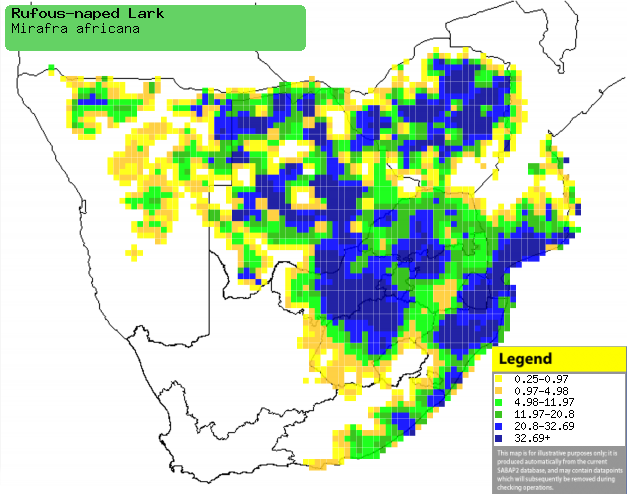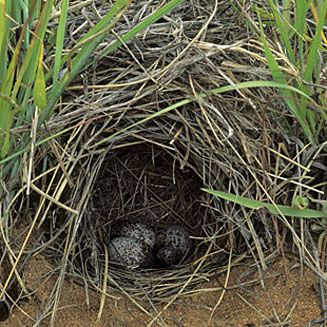|
Mirafra africana (Rufous-naped
lark)
Rooineklewerik [Afrikaans]; Igwangqa, Iqabathule [Xhosa];
uNgqangendlela, uNongqwashi [Zulu]; Yisimatuli (generic term for lark)
[Kwangali]; Tsiroane [South Sotho]; Mapuluhweni (generic term for lark)
[Tsonga]; Sebotha (generic term for lark) [Tswana]; Roodnekleeuwerik
[Dutch]; Alouette à nuque rousse [French]; Rotnackenlerche [German];
Cotovia-de-nuca-vermelha [Portuguese]
Life
> Eukaryotes >
Opisthokonta
> Metazoa (animals) >
Bilateria >
Deuterostomia > Chordata >
Craniata > Vertebrata (vertebrates) > Gnathostomata (jawed
vertebrates) > Teleostomi (teleost fish) > Osteichthyes (bony fish) > Class:
Sarcopterygii (lobe-finned
fish) > Stegocephalia (terrestrial
vertebrates) > Tetrapoda
(four-legged vertebrates) > Reptiliomorpha > Amniota >
Reptilia (reptiles) >
Romeriida > Diapsida > Archosauromorpha > Archosauria >
Dinosauria
(dinosaurs) > Saurischia > Theropoda (bipedal predatory dinosaurs) >
Coelurosauria > Maniraptora > Aves
(birds) > Order: Passeriformes
> Family: Alaudidae > Genus: Mirafra
Distribution and habitat
Although it has scattered populations across much of West
Africa, the bulk of its distribution lies from Kenya and Tanzania to Angola,
Zambia and southern Africa. Here it is fairly common to common in a wide variety
of open habitats with grass, such as savanna, open woodland grassy fynbos,
fallow fields and open ground near cultivated land. It dislikes dense grassland,
as it prefers having bare patches of soil for foraging and scattered bush and
fence poles to use for singing.
|
 |
|
Distribution of Rufous-naped lark in southern Africa,
based on statistical smoothing of the records from first SA Bird Atlas
Project (©
Animal Demography unit, University of
Cape Town; smoothing by Birgit Erni and Francesca Little). Colours range
from dark blue (most common) through to yellow (least common).
See here for the latest distribution
from the SABAP2. |
Food
It mainly eats arthropods supplemented with seeds, doing
most of its foraging on the ground, gleaning food from the bases of plants and
taking termites as they emerge from their mound. The following food items have been recorded
in its diet:
- Invertebrates
- Insects
- earthworms
- millipedes
-
spiders
- solifugids
- Seeds of grasses and forbs
Breeding
- The nest (see image below) is a partially or completely domed cup of dry
grass, lined with finer plant material. It is typically placed in a scrape
in the ground at the base of a grass tuft or shrub.
 |
|
|
Rufous-naped lark nest with eggs, Sericea
farm, South Africa. [photo
Warwick Tarboton ©] |
|
- Egg-laying season is from July-April, peaking from October-February.
- It lays 2-3, rarely 4 eggs, which are incubated for about 14-15 days.
- The female broods the chicks and does most of their feeding, while the
male contributes to a lesser extent. The young eventually leave the nest
after about 10-12 days, before they are able to fly.
Threats
Not threatened.
References
-
Hockey PAR, Dean WRJ and Ryan PG 2005. Roberts
- Birds of southern Africa, VIIth ed. The Trustees of the John Voelcker
Bird Book Fund, Cape Town.
|
